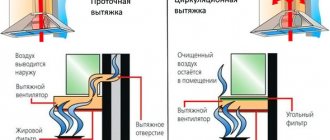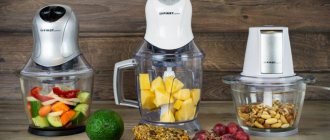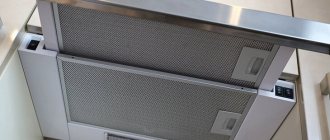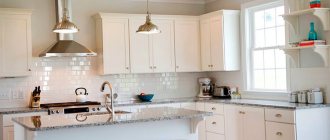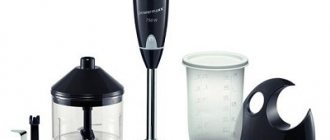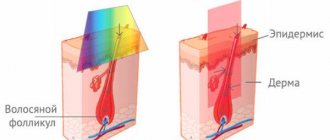Technique
0
7 158
Share
An air purifier for the kitchen is a device designed to process harmful impurities, purify indoor air, and preserve human health. Today, a lot of different models are produced, differing in technical characteristics, operating principle, and cost.
Polluted air purifier for kitchen
- Classification of devices
- Technical specifications
- Hood or air purifier: which is better?
- Installation
- Kitchen air purifier kits
- Care Tips
- Air purifier models
Difference in purpose
At first glance, in both cases we are talking about air purification. However, the nature of its contamination may be different. It’s one thing to have ordinary, heterogeneous dust; another thing is to have an atmosphere saturated with tiny fat droplets, fumes, and burning products, heated to high temperatures. In the first case, an air purifier, which can be equipped with humidification and ionization functions, copes with contaminants. In the second, the problem is solved by a household hood used in the kitchen. Hence the difference in the definition of these devices:
- An air purifier is usually defined as a device for cleaning dusty air in a room;
- A household hood is a device for eliminating smoke, fumes, burning, and other odors accumulated in the kitchen area that arise during the heat treatment of products.
Recommendations for selection
Small models can be installed in every room.
To choose the right air purifier for the kitchen, you need to pay attention to the following factors:
- Room volume. The device must have a work area commensurate with the kitchen.
- Air pollution level. The greater the degree of contamination, the more powerful the model will be required and the more often the filters will need to be changed.
- Functionality. The average throughput of the device should be 150-700 cubic meters/hour.
The noise factor should also be taken into account when choosing equipment. The quieter it works, the higher the quality.
Design differences
The difference in purpose affects the design features, but first let’s talk about the similarities. Since both devices deal with air, there is a suction or exhaust element in the form of a fan with an electric motor. Often its cleaning is carried out according to a similar scheme: using a built-in filter system. Then the differences begin:
- most hoods use directional extraction and are mounted directly above the hob, preventing fumes from escaping beyond the working perimeter;
- the purifier is capable of taking air anywhere and does not require rigid fixation;
- a hood, like an air purifier, can operate in recirculation mode, but often the design operates in flow mode and requires a connection to the ventilation shaft;
- in the first case, the design provides fastening points that allow you to secure the device above the stove; in the second, the device is not tied to one place, although fastening connectors may be provided;
- exhaust equipment is equipped with more powerful filters that are capable of removing complex contaminants; purifiers are more diverse in the number of cleaning methods.
The most important element is the filter
The air flow is forced through the filter system, each time leaving particles of various types of contaminants on them. When it passes through the grease absorber, it traps grease and grime. Catcher filters made of aluminum or metal, reusable. Filter elements made of acrylic fiber are also subjected to soapy water treatment. Consumable items that require mandatory replacement include padding polyester, paper, and non-woven filters.
Carbon filters are responsible for fine cleaning
The air is purified by a finer treatment in a carbon filter. The coal spherosomes contained in it trap the smallest fractions of fat, smoke, dust, and also partially neutralize unpleasant odors. But a carbon filter is powerless against carbon monoxide.
Both types require maintenance. Grease-absorbing cleaners are washed as deposits settle or replaced with new ones. In the latter case, acrylic or padding polyester consumables must be replaced, which are thrown away immediately after it is impossible to make out the inscriptions on them. If the air purifier is located above a gas stove and is not cleaned, then an open fire may cause ignition of flammable residues.
Important! Carbon cleaning consumables must be replaced at least every 6 months or even more often (depending on the use of the stove).
The design may include electrostatic cleaners that deposit dust particles on the electrodes. In more expensive models, the photocatalytic element helps decompose the smallest particles into components that are safe for the body. From the above list, at least two types of filters are used to completely purify the air.
Differences in cleaning methods
Both types of cleaning technology can operate in a recirculation version. In this case, the air taken from the room passes through the filters and returns in a renewed state, ready for reuse. With this cleaning scheme in the kitchen hood, odors and fumes are retained by carbon filters, while oily vapors are collected by a grease filter. In an air purifier, the circulating filtration system is more diverse. It can be:
- the same carbon filters,
- photocatalytic cleaning,
- thin HEPA filter,
- electrofiltration,
- water wash.
Flow operation scheme
An alternative to recirculating kitchen exhaust hoods is venting or flow cleaning. To work on this principle, it is necessary to connect to the ventilation shaft of a high-rise building or independently organize an outlet to the outside. This complicates the installation of exhaust equipment and requires the use of additional equipment. In this regard, a hood is more complex than an air purifier. It can simply be placed on a table in a room whose atmosphere needs cleaning and plugged into the network.
Additional functions
Depending on the cost category, both devices can be equipped with a range of additional functions. They provide the device with greater functionality and greater comfort for the user. The list of such amenities of both devices may include:
- an atmosphere control sensor with an automatic switch capable of activating the desired operating mode;
- timed shutdown, which allows you not to worry about timely shutdown of the device with the appropriate settings;
- a system for indicating the status of filters in audio and/or visual form, which allows for timely replacement and cleaning;
- remote control via a remote control, which makes the device as convenient as possible to turn on and configure, especially for those whose mobility is limited by a congenital or acquired illness.
Purifiers can be equipped with ionization and humidification functions. For flow-through exhaust systems, an important option is a check valve, which blocks the reverse flow from the ventilation.
Signs you need cleaning
Before you begin cleaning, you need to become familiar with the signs that indicate that your ventilation system needs to be cleared of debris.
These include the following:
- Dust formation. If the hood needs cleaning, dust or other small debris will accumulate near the exhaust vent.
- Raid. A dark coating on the surface of the grate indicates the need for cleaning. It may also become coated with particles of fat or soot.
- Fast heating of the room. If the ventilation system starts to work worse, the room warms up faster.
- Reducing drafts. With poor air circulation, the draft becomes much weaker.
Design and purpose of the ventilation system
Many people think that the air in the apartment is clean, but this is not the case. In fact, it absorbs various odors that come from the kitchen or from the street. It also contains dust particles, small lint, and even animal hair. Over time, the air accumulates a lot of dangerous bacteria and microorganisms that contribute to the formation of mold and mildew in the room.
Therefore, it is recommended to take care of organizing a high-quality ventilation system that performs the following functions:
- promotes the flow of clean air into the room;
- removing dust, bacteria, carbon monoxide and unpleasant odors from the room;
- normalization of humidity levels.
Review of popular models
FALMEC Dodraft 600 120 WH
The choice is huge. The most popular models:
- FALMEC Dodraft 600 120 WH – coal hood built into the countertop. The design is fantastic: stainless steel with tempered glass inserts. Works in 4 modes, including high-speed.
- Smeg KSC90B is an option for an island kitchen or combined with a living room. Ceiling mounted. Its feature is pericentral air suction, so there is no guarantee that odors will appear in the room. The productivity of the device is 830 m³/hour.
- Miele DA 7090 W BK – works in 3 modes, designed for a large family. Model productivity – 550 m³/hour. At the same time, the device has an unusual design: it can be safely installed in a studio apartment or office.
- Bosch DHI646CQ is a device with a retractable panel that increases the width of the suction zone. Capacity 300 m³/hour. It works in 3 modes and has a high degree of fat filtration.
Features of the hood
A hood is a type of ventilation system. It is designed to remove air. Many models also have an air recirculation function. Recirculation mode is sometimes called air purification mode, and it works by sucking air through one opening, passing it through filters, and then releasing the purified air back into the room through another opening. For these purposes, carbon or synthetic filters are usually used. A mesh metal filter is used to filter grease.
Important! The main characteristic of a hood is performance. It is measured in the volume of air per hour that it can pass through itself; in the characteristics, this parameter is indicated in units of m3/h.
Structurally, the hood is a device for air intake, in which an electric motor acts as a power element, and the main functional unit is a turbine or fan. With its help, air masses move. Most hoods have a suspended design and are attached either to the wall or to the ceiling. According to their shape, there are corner, wall, island (ceiling) and dome hoods.
Corner hood Wall model Island hood Dome version
In order for the hood to work, it must not only be mounted on a wall or ceiling, but also the air pipe must be routed into the ventilation duct. This may cause problems both for residents of private houses and, in some cases, for residents of apartments, especially if the house is old and built of brick. In such cases, the air duct is led through the wall directly to the street. In panel houses, ventilation ducts are usually provided by the design of the panels themselves. These factors complicate the installation of the hood and, accordingly, it is more expensive.
Hood installationAttention! If you have a gas boiler or water heater installed, problems may arise when using one ventilation duct, for example, the occurrence of reverse draft, and this is dangerous for property and even your life.
The industry produces hoods of various sizes, starting from approximately 50 cm wide, which allows it to be installed even in very small kitchens.
Advantages and disadvantages of hoods
Let's summarize and list the advantages and disadvantages of hoods.
Advantages:
- the ability to operate in two modes - air exhaust and air recirculation;
- wide range of constructive solutions, designs and sizes;
- the cost of the hood starts from 20-30 dollars;
- the noise level of most models is within 50-60 dB and does not cause inconvenience to users;
- if there is no recirculation function, then the filters do not need to be changed - the metal mesh filter is simply cleaned periodically. In models with a recirculation function, filters are changed depending on the frequency of use, from once a month or less.
Flaws:
- the need to install a pipe to exhaust air into the ventilation duct or to the street. This is not always possible and can also be expensive;
- Depending on the location of the stove, the length of the air duct may vary. To the point that you will have to lay it through the entire kitchen, and this will not only worsen the appearance of the room, but can also cause problems with the installation of a set of kitchen furniture and hanging cabinets;
- Warm air is drawn out of the room.
How to switch the hood from exhaust mode to recirculation mode?
Almost all air purifiers on the market can operate in two modes. In exhaust mode, the air exits through the outlet at the top or rear of the hood and then through the air ducts into the ventilation. To switch the device to recirculation mode, you need to close the outlet with the plug included in the kit and move the lever to change the direction of air movement. A kitchen air purifier configured this way can be mounted directly to the bottom of a wall cabinet. However, it should be mentioned that flat models are usually switched this way. Built-in ones, which in any case come with ducts and air ducts, do not make sense to reconfigure.
Features of air purifiers
An air purifier is a device designed to clean the air from odors, smoke, steam and dust. This means that it can only operate in recirculation mode. In this regard, for high-quality air purification, dense filters are installed, which causes an increased noise level.
The air purifier only works in recirculation mode
The air purifier does not require the installation of an air duct and its connection to the ventilation ducts. This makes installation of the device easier and, accordingly, reduces its cost. This means that the air purifier can be installed in rooms with any type of layout and wall structure.
Unlike hoods, air purifiers are produced in a wider range of designs; there are also devices for wall mounting, and for installation on the floor or on a table.
The following types of filters are distinguished:
- The pre-filter is made in the form of a fine mesh. Serves as a coarse filter to retain large particles, such as animal hair and other particles 5-10 microns in size. It also serves as a protection for finer filters;
- Carbon filters - these are often used in hoods. Another name is adsorption. The porous structure of coal absorbs odors, particles and gases. During operation, the pores of the filter are filled with microparticles, so they must be replaced periodically - approximately once every 3 months;
- HEPA filters. The name stands for High Efficiency Particulate Arresting. It traps particles up to 0.3 microns in size, namely: dust, wool, pollen, animal dander, dust mites. This type of filter is also used in vacuum cleaners. They are made from different materials, for example, disposable ones are made from paper and fiberglass, and washable models are made from fluoroplastic fibers and activated carbon;
- Photocatalytic filters. They decompose organic matter into harmless compounds under the influence of ultraviolet radiation on a photocatalyst;
- Air washing or water filtration. The principle of operation is to pass air through charged electrodes, after which charged particles settle on wet disks. The dust is washed off from them and falls into the pan. The advantage is that this type of filter does not require replacement;
- Electrofiltration. The principle of operation is the presence of electrodes between which an electric field is created and particles from the air that passes through them are retained in the filter. It is cleaned by washing with soapy water.
Air purifier filters For information! Air purifiers are usually equipped with two or more filters - this is necessary for effective air purification.
Advantages and disadvantages of air purifiers
Advantages of air purifiers:
- can be either suspended, similar to kitchen hoods, or stationary (tabletop), which allows use in any room;
- installation does not require connection to ventilation ducts;
- Warm air does not escape from the room.
Flaws:
- increased noise level;
- the need to replace most types of filters.
Basic installation rules
Before installing any type of cleaning device, there are two recommendations to consider:
- Take care of the outlet. Ideally, it should be located at the level of the hood, and the cable should be hidden in the wall, since neither the socket nor the wire should be exposed to steam and heat. It is recommended not to use an extension cord that has extreme tension or sagging in the cord, as this is unsafe.
- Determine the installation location above the stove at a height of 75 cm. This way, the air purifier will capture all fumes and will not be affected by heat and steam.
The installation of a recirculation and flow device differs from each other. To understand the differences in detail, it is worth considering the installation principle of each device:
- Air purifier with recirculation mode . This model is easy to install yourself, since all the necessary components for installation are included in the kit along with a cleaner, installation instructions and a sheet with markings for fastening. All markings are checked using a building level. After the device is secured, it is plugged into the outlet. It's ready to go.
- Hood with “outlet” mode . Installation of these models is more labor-intensive, since it is necessary to connect the corrugated hose to the ventilation. They adhere to this order: markings are made on the wall and screws are screwed in, on which the hood is hung. Next, they begin to install the air duct, for which they use an adapter. A corrugated hose is attached to it, and then tightened with a clamp. The second end of the corrugated hose is connected using a clamp to the ventilation hole, onto which a grille with an adapter is pre-installed.
Experts recommend using plastic air ducts instead of corrugated hoses, which have a more aesthetic appearance, but are more expensive.
Air purifiers are devices that help cope with the smell of fat and burning, soot, gas combustion products, dust, hair, unpleasant odors and toxic substances. When purchasing them, you need to take into account the size of your own kitchen and stove, as well as financial capabilities. Whatever air purifier you choose, do not forget that it needs regular maintenance and timely replacement of filters.
Types of Kitchen Air Purifiers
According to technical parameters, air purifiers are usually divided into three groups:
- exhaust;
- recirculation;
- mixed.
The exhaust system removes dirty air through a special hole and is an example of a classic hood, which has a typical shape (flat or dome) and is located above the gas stove.
Recirculation units process the air inside and release purified air outside. Impurities remain on the device filters. This type of mechanism allows you to make the air in the room clean and fresh, which has a beneficial effect on the atmosphere in the kitchen and the preservation of the external decoration of the walls and ceiling.
There are also devices that combine two types of mechanisms: recirculation and exhaust. Such devices are called mixed.
Types of Filters in Recirculating Air Purifiers
In turn, recirculation purifiers can have different types of filters:
- Mechanical in the form of a mesh for screening out large contaminants (specks, animal hair, hairs, etc.). “Coarse” cleaning is the first stage of filtration, and therefore such a mesh is included in any purifier.
- Electrostatic ones attract the smallest contaminants. They create a stable electric field around themselves, which helps attract charges of different polarities. Such filters do not even need to be changed, but only occasionally cleaned yourself.
- Photocatalytic ones help break down the molecules of large contaminants into the smallest harmless particles.
- Charcoal is necessary for drawing in and processing bad odors. But these filters cannot remove absolutely all odors, especially very strong or poisonous ones, such as carbon monoxide.
It is also customary to classify air purification equipment according to the type of installation and installation.
Often this parameter depends on the type of device mechanism. The following groups are distinguished:
- In the shape of a dome, which are placed above the stove. Most often, such devices have an exhaust type mechanism and exhaust air into special openings. These are standard hoods, for which space is usually calculated when developing an interior design.
- Appliances that are suspended above the stove. Hanging air purifiers usually have a recirculating mechanism.
- Devices that are built into kitchen appliances. Most often they have a mixed type of operating mechanism.
- Mobile devices. They are active only during air processing and are suitable for use throughout the apartment, as they can be easily removed and installed in a new location.
Hood or air purifier?
Despite the similarity of these two types of devices, hoods and air purifiers have a clear difference: hoods are used only in the kitchen, while purifiers can be used throughout the apartment, if necessary. One of the most important qualities of air purifiers for the kitchen and home is mobility and versatility.
The most different from hoods are recirculation devices . They are even practical to install, because their installation does not require exhaust ducts; it is enough to hang the device in the right place above the work surface. Typically, such filters are used above the stove in the kitchen to process gas decomposition products.
The disadvantage of purifiers with a recirculation and mixed type of mechanism is the need to change expensive filters, which will have to be included in a mandatory family expense item. In addition, these devices are quite noisy, because the air is forced through several different filters until it is completely cleaned.
The advantage of filtration technology is the preservation of heat, because purifiers recycle air rather than drawing it out into the street. Filtration devices do not affect the level of humidity in the room, unlike a hood, which draws out moisture along with contaminants.
In turn, exhaust equipment does not need to change filters, and polluted air is simply drawn out and dissolves in the atmosphere. The downside is the need to constantly wash the device, since too high temperatures during cooking create heat and soot, which can settle on the walls.
The hood is quieter than the recirculating and mixed purifier, making it a better option for those who don't like noise.
Pros of recirculating purifiers:
- Easy to install.
- Thermal safety.
- Complete air purification.
- Versatility.
- Mobility.
Pros of hoods:
- Silence.
- Economy.
- Practicality.
The choice of a range hood or recirculating air purifier for a kitchen over the stove is determined by a number of factors, for example, the price issue or the kitchen design designed specifically for a dome hood.
The price of air purifiers is higher than that of classic hoods, and you also need to constantly buy new filters, which can be a costly endeavor.
Which is better: an air purifier or a range hood?
Air purifier
63.64%
Hood
36.36%
Voted: 22
The nuances of installing air purifiers
As mentioned above, the installation of devices with recirculation and flow operating principles is different. You should select a location for the hood so that you can easily connect an air duct to it and then connect it to a common ventilation shaft. Ideally, it is recommended to purchase an air purifier in combination with kitchen furniture so that its model fits into the design of the room.
The installation process is simple, but a number of nuances should be taken into account:
- you need to calculate in advance the location of the outlet from which the installed device will receive power, so that its wire is not stretched and does not come into contact with the heated parts of the stove;
- You need to install the air purifier before arranging the kitchen furniture, in order to be able to pre-determine the direction and area of its action, and conveniently arrange all the components of the set around the room.
Installation diagram of a flow cleaner
The optimal distance of the purifier from the stove is 0.75 m, which meets fire safety requirements. This arrangement allows the device to draw in all fumes emanating from the stove.
It is not recommended to connect the device through an extension cord. The best option for the location of the outlet is to place it hidden in the cabinet at the level with the purifier.
Installation
Installing an air purifier in the kitchen will only be effective if you take into account the size of the room and its air circuit. If the room has large volumes and the stove is used infrequently, then using the device is quite justified.
A compact gadget is necessary in every apartment
In such cases, the level of pollution is not too high, and the air purifier can do a good job. In small rooms it is better to install dome or built-in kitchen hoods, which differ in the circulation principle of operation.
Installing an air purifier yourself is not difficult. However, there are some nuances here too:
- Installation of the device must occur before installation of the headset items. This will help to correctly indicate the direction of its action in the area where the hob is located and to arrange other components on the wall.
- Calculate the location of the future outlet in advance. The air cleaner wire should not bend, be too tight, or be too close to the heating unit. The best option is if the socket is placed on the same level as the technical equipment inside the kitchen cabinet.
- The height of the air purifier above the cooking surface must comply with fire safety standards. The most suitable distance is 75 cm. This arrangement allows you to capture the entire mass of vapors without being subjected to severe overheating.
A kitchen filter above the stove can be installed instead of a hood if it is necessary to organize the outflow of air regardless of the operation of the air purifier.
The built-in air purification device is completely invisible in the kitchen
Comparison of the distinctive parameters of an air purifier and a hood
To consolidate the above, let’s compare hoods and air purifiers according to a number of parameters.
Purpose
The hood is designed to remove air outside the room, but most models can also operate in recirculation mode. Air purifiers operate only in recirculation mode , but due to their design features, they cope with this task better than hoods.
Air recirculation scheme
Principle of operation
The hood works by sucking odors, steam and smoke out of the room. With the help of an electric fan, air flows into the ventilation ducts.
The air purifier passes air through a group of filters and is not connected to ventilation. The performance, noise level and quality of operation of the device depend on the quantity, quality and condition of the filter elements.
An air purifier passes air through filters
Design differences
Structurally, air purifiers differ from hoods in the following:
- The air purifier does not have a channel for connecting to ventilation;
- Installing a hood is more difficult and requires the ability to vent air outside;
Hood installation is more complicated - The hood usually has 1 or 2 filters (mesh and carbon), and the air purifier has 2 or more;
- Due to the filter elements, the throughput of the air purifier is worse, so it is more difficult for air to pass through it, hence the increased noise level of these devices.
Cleaning methods
The filter elements of hoods and air purifiers must either be replaced or cleaned. However, in hoods there are fewer elements and the carbon filter must be replaced, while the mesh filter can simply be washed. While half of the filters used in air purifiers are disposable. This leads to the problem of increased operating costs for the air purifier.
The mesh filter can be simply washed
How to determine the required air purifier performance?
It is determined by the formula: “Room volume * 10 = Productivity”, where 10 is the air exchange rate, i.e. a number indicating how many times per hour the air in the room is completely renewed. Let's say the kitchen area is 9 m². Standard ceilings are 2.5 m. Then the minimum required power of the air purifier is: 9 * 2.5 * 10 = 225 m³/hour.
If a corrugated hose is attached to the hood, through which air will be removed, then at each turn of the hose the power will drop by about 10% - this should also be taken into account.
Of course, there are more complex calculations that take into account the need to pump air through air ducts or the volume of furniture in the room, but the average person has no need to delve into them. The above formula is enough to estimate the required performance before purchasing.
Technical specifications
Each air purifier for the kitchen has its own technical parameters. To determine whether a device is suitable for a particular room, you need to find out:
The flow-through appliance throws kitchen fumes and soot out
- Working blade size;
- Performance;
- The height of the noise.
Working blade size
The size of the working surface of a stationary air purifier must be greater than or equal to the size of the plate. There are three standards for hoods: 60, 90 and 120 cm. Some owners install cooking appliances in the center of the kitchen or form an island from several surfaces. In any option, it is necessary that the air purifier controls the entire slab surface.
Performance
Productivity is the amount of air mass that the device passes through in one hour.
The calculated productivity of the air purifier must be higher than that specified in the technical data sheet.
To determine the calculated indicators, the volume of the room is multiplied by 12 (the air exchange rate for the kitchen) and by 1.3 (the level of air pumping through ventilation in a multi-story building). In one-story houses, the last indicator can be neglected.
Noise
Air purifiers for the kitchen cannot be called low-noise devices. The maximum noise level is 65 dB, but in general, kitchen air purifiers are noisy at 55 dB. For comparison, the same indicator for a refrigerator is 45 dB, and the centrifuge for a washing machine produces 68 dB.
Type of hood in the kitchen interior
In order to select an air purifier, it is necessary to determine the intensity of pollution and the required functionality. The main requirement for the device is to clean the air and remove harmful substances from it. The device does not require the installation of ionizers or oxygen enrichers, which will only complicate its maintenance.
Types of Kitchen Cleaner Models
Today, you can find dozens of types of the most modern designs in the retail chain. The principle of operation of all of them comes down to one of the options:
- circulating air exchange;
- removal of contaminated air through ventilation;
- combined operation: recirculation and removal of air after pre-cleaning.
Air circulation inside the kitchen saves heat in winter without venting it outside. The flow-through model is the quietest in operation and does not require filter replacement.
Models differ in type of layout:
- Built-in. The element of the kitchen environment is mainly of a combined type: from a given mode they work to circulate air (in winter) or to remove it.
- Kitchen air purifiers without hood above the stove, suspended type (recirculation mode).
- Mobile air purifiers. They only distill air through themselves, but thanks to the presence of additional elements (an electrostatic filter), they polarize particles of contaminants and deposit them on the electrodes.
Attention! Additional options may be available: humidification, ozonation, organic decomposition, etc.
Main causes of blockages
There are six reasons why blockages in the ventilation may appear.
Accumulation of dust, dirt, grease
The main reason why the ventilation system begins to function worse is the accumulation of particles of grease, dirt and dust. All these contaminants gradually accumulate on the surface of the walls of the shafts or air circulation channels.
Most often, pollution accumulates due to too narrow channels through which waste oxygen moves from the bathroom, kitchen or living rooms.
Moving inside the system, all the particles of garbage gradually accumulate. Over the years, the mud layer increases, causing air to move much more slowly. Therefore, experts recommend periodically cleaning the ventilation system to prevent debris from accumulating in it.
Brick collapse
The most serious reason that leads to poor air circulation is collapsing brickwork. It is from brick that the ventilation shaft is constructed in many houses. To fix this problem, you will have to clean and repair the broken shaft. However, sometimes it is difficult to cope with such a problem on your own, and therefore many have to live with a damaged ventilation system.
Small animals and birds
Often birds and other small animals get inside the ventilation hood. This happens in winter, when lukewarm air begins to rise from exhaust pipes, emanating from bathrooms or kitchens. Warm air currents attract birds, and because of this, they fly up to the ventilation holes and begin to sit on them to warm up a little. Most often, sparrows and pigeons flock to warm themselves, which are most numerous in cities. Some of the birds sitting on the pipes fall into the ventilation, which is why it begins to work poorly.
Another reason why birds fall into pipes is because they are trying to build nests in them. Therefore, there may be chicks at the bottom of the mine, and not just adults.
Kitchen hood
Sometimes when installing a kitchen hood, people cut it into the ventilation duct. This should not be done, since conventional ventilation is designed to pass through about 90 cubic meters of air per hour. This figure is more than ten times less than the performance of most modern models of exhaust structures. Therefore, when a hood is installed inside the ventilation shaft, excess pressure is created, due to which air flows begin to be pushed into neighboring apartments.
Before installing a hood in the kitchen, you need to consult with a specialist so that he can explain where it can be installed.
Replacing wooden windows with plastic ones
It is no secret that for the normal functioning of the ventilation system, a constant supply of fresh air is needed. If it is not there, air circulation will deteriorate significantly. The use of a new sealed plastic double-glazed window impairs the flow of air into the room, which leads to periodic fogging of the glass and the appearance of traces of mold on the surface of the walls. How to quickly wash blinds at home, the best folk and chemical remedies
To avoid problems when using plastic windows, it is necessary to periodically ventilate the room even in winter. Some people recommend installing wooden windows, but they retain heat less well.
Seasonal features
There are also seasonal features that affect the quality of ventilation. For example, in winter it works well and without interruptions, but in hot weather its performance can deteriorate significantly. This is due to the fact that in winter the temperature difference between outside and inside is too high.
In summer, the temperature difference is not so significant, and therefore air ventilation becomes worse. To normalize it, you will have to open windows or install forced ventilation devices for better air circulation.
Types of hoods without duct
A hood without a ventilation outlet is designed simply, so there is not much variety in the models. However, due to the ease of installation, it becomes possible to mount models in different ways.
By design
The body of the recirculation hood can have a different design and shape. Devices are divided into 4 groups.
- Horizontal - placed strictly parallel to the hob. This is a classic rectangular model. It takes up quite a lot of space, but at a high altitude.
- Vertical - located perpendicular to the slab, usually in close proximity to the slab. The need for such an installation arises if it is impossible to place the structure above the stove - furniture, some equipment, or an architectural element is in the way. A vertical hood also captures smoke and odors well. Since it is located almost in front of the wall, it takes up little space.
- Inclined - fixed at an angle. It is highly efficient and quiet. At smaller sizes, the angled panel filters a large volume of air. In addition, the inclined model can be installed at a lower height.
- Telescopic – with a retractable panel. When cooking, the hood is pulled out to the desired position, and after work it is returned to its place. A very convenient solution that saves space.
Only the telescopic model differs significantly in price. The remaining designs cost approximately the same.
By installation method
Kitchen hoods are also classified according to the installation method.
- Hanging – fixed to the wall at any convenient height. Mounting on brackets.
- Built-in – mounted inside the kitchen unit. Most often this is a hanging cabinet. It hides the hood, but at the same time retains its working volume. This solution is often found in classic kitchens, where modern appliances have to be disguised.
- Island - installed on the ceiling. This model is placed far from the wall, above the kitchen island. This is much more profitable than venting to a stove located in the center of the room.
Telescopic installation is a type of built-in installation.
Designs are also divided according to other features: stationary and retractable . The first ones are fixed. In retractable models, the hood panel moves. This increases the efficiency of the device.
According to the shape of the body
Until recently, the design of hoods was simple. Today they offer different options:
- flat panel - usually rectangular, compact and unobtrusive;
- dome - volumetric hood;
- curvilinear - may have unusual shapes of a flat panel and a curved dome.
Kitchen hood - an example of local ventilation
Designer versions of the device are quite rare. Such models are usually part of the kitchen complex and form a harmonious whole with it.
According to case material
For production, materials are taken that are resistant to corrosion and easy to clean.
- Galvanized steel coated with enamel - the body is quite light, durable, easy to clean, and inexpensive. Enamel and a layer of zinc protect the steel from rust.
- Stainless steel is a more expensive but much more durable option. The hood is not afraid of high dampness, is insensitive to temperature changes and is very durable. In addition, stainless steel is much more decorative: the surface of the body can be ground, polished, structured.
- Aluminum is a lightweight metal that is completely insensitive to corrosion. It is easy to clean, you can use abrasive care products, but be careful, since the mechanical strength of aluminum is low. The lighter shade and shine will attract techno and loft lovers.
- Tempered glass is a very stylish, elegant and expensive option. The transparent or translucent body looks fantastic. The material is strong, hygienic and durable. It can only be washed with water and detergents. When installing, you need to be careful: tempered glass, although durable, is fragile, and its weight is high.
The material of the housing affects the care. Glass models are the most capricious.
Additional functions
Almost all hoods are made with lighting.
A kitchen hood with a filter is an electrical device. This allows you to provide it with additional functions:
- Models may have a mechanical or electronic control panel . In the first case, adjustment is carried out using buttons or sliders. The first option is preferable. The slider often begins to jam as fat gets into the gap.
- The electronic panel allows you to control the hood using a touch screen or remote control . If the hood is island, this option is more convenient.
- Filter contamination indicator – signals the condition of the carbon filters, since it is their condition that needs to be closely monitored.
- Automatic switching on and off – the hood starts working on its own as soon as the sensor detects the appearance of soot or odors.
- Speed change option - in this model you can adjust the filtration intensity, which depends on the volume or duration of cooking.
- Backlight – creates additional lighting near the stove. A convenient option for cooking in the evening.
The more additional functions, the higher the cost of the device.
How to upgrade your ventilation system
Sometimes in old houses even cleaning does not help improve the performance of the exhaust structure. Therefore, it is necessary to increase air circulation in other ways. There are methods available to improve ventilation. For example, you can install modern double-glazed windows that have a micro-ventilation function. Such windows promote air circulation in the room. You can also use special fans to improve air flow. Such exhaust devices are installed in the bathroom, toilet or kitchen.
Where to go if you can’t clean it yourself
It should be noted right away that cleaning the ventilation in an apartment building is the responsibility of a special organization that has entered into an agreement with the management company. It is prohibited to clean the vertical ventilation shaft yourself. And it is impossible to do this qualitatively with improvised tools and devices.
Therefore, you need to come to the office of the management company and leave a written statement, indicating the entrance number and house number. The thing is that one vertical ventilation shaft is often installed per entrance. Therefore, it will be easy to search for it if the entrance number is indicated.
Specialists who arrive on call must first take measurements of the air speed in the ventilation system. One froze from the side of the apartment, the other from inside the mineshaft. After which it is determined what activities will be carried out. By the way, in addition to cleaning, it is proposed to carry out disinfection or repair.
Please note that the question of who should clean precisely determines the responsibilities of the parties. That is, the management company does not do this itself. She simply monitors the requirements of the residents of the apartment building and their implementation by her employees or persons with whom there is an agreement to carry out certain events. But residents must demand the work be completed from the management company.
